Sukhoi Su 30MKI
- Thread starter LurkerBaba
- Start date
More options
Who Replied?Assassin 2.0
New Member
- Joined
- Aug 13, 2019
- Messages
- 6,087
- Likes
- 30,705
Can SU-35 super cruise????????No newer engine.... very bad. IAF should have gone for s117 engine. It would have allowed SU30MKIS to supercruise...
lcafanboy
New Member
- Joined
- Mar 24, 2013
- Messages
- 5,875
- Likes
- 37,838
Yes......it does......................Can SU-35 super cruise????????
vampyrbladez
New Member
- Joined
- Jun 21, 2018
- Messages
- 10,283
- Likes
- 26,675
My observations on this issue :
1. IAF will only upgrade around 220 Su 30 MKI to Su 30 MKI+ standard. This is due to budget crunch and technological obsolescence.
https://idrw.org/iaf-says-no-to-russias-engine-swap-offer-for-its-su-30mki-fleet/
2. The Su 35 BM style Su 30 MKI cockpit will be part of the upgrade.

Su 35 BM Cockpit
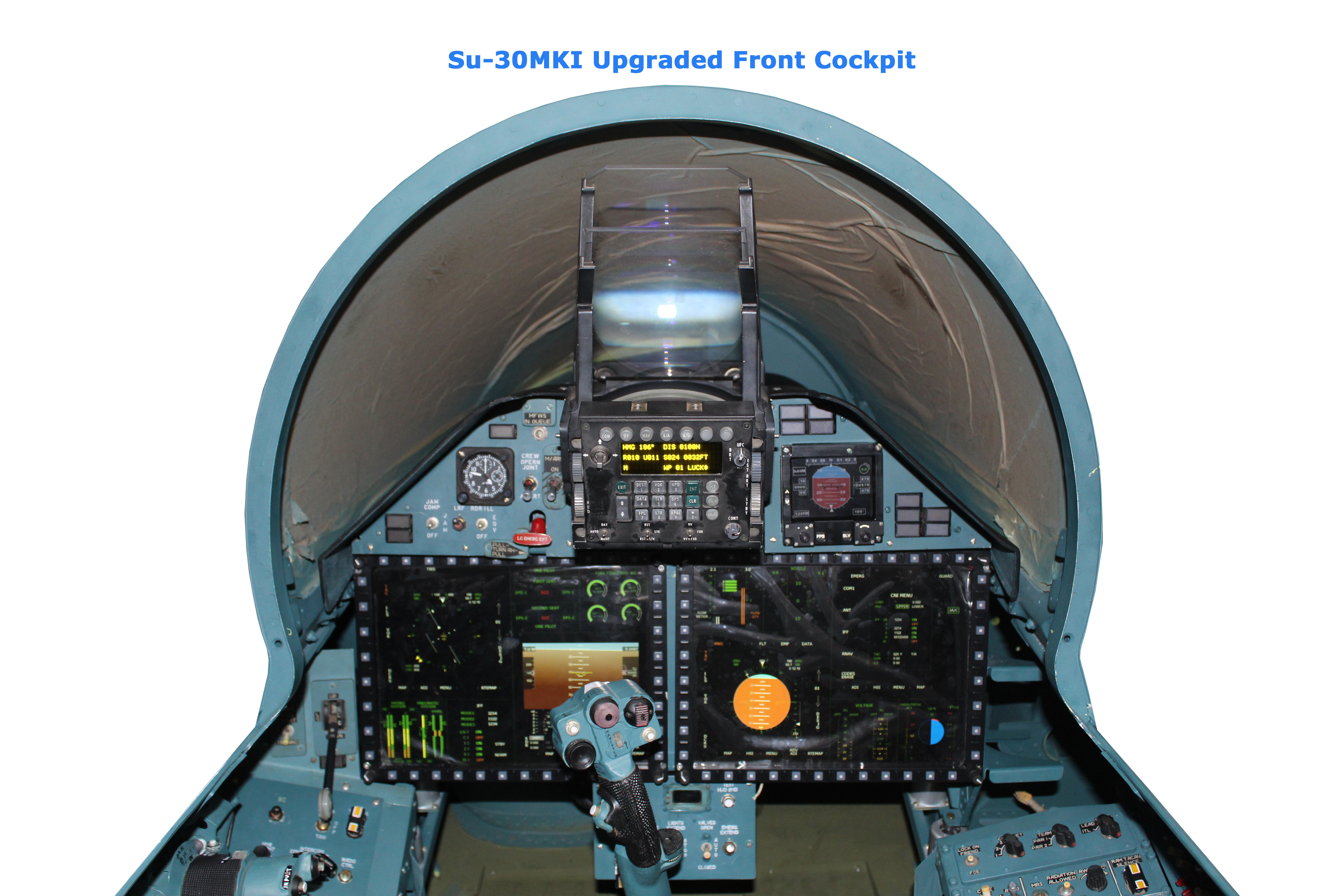
(NEW)
Vs
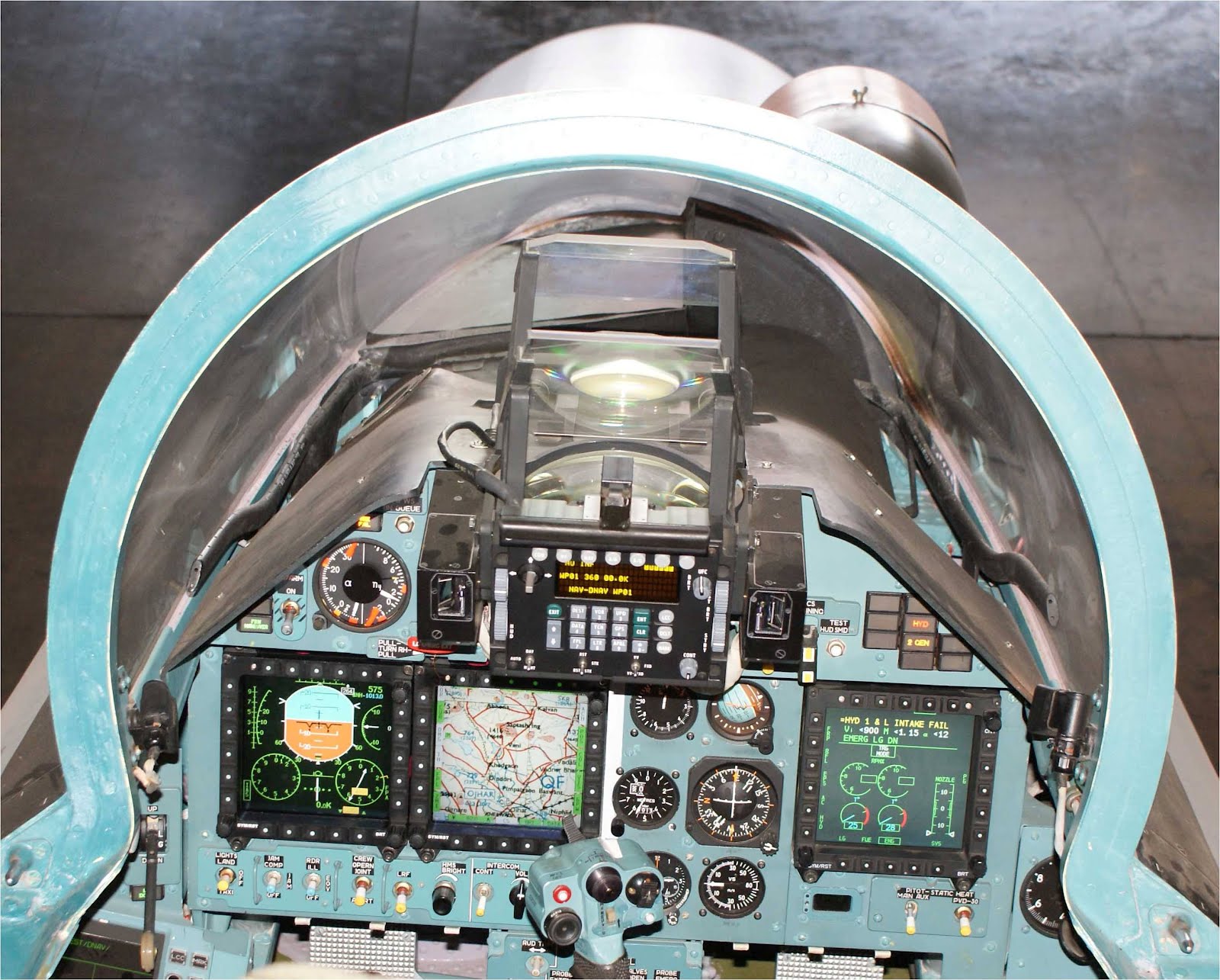

(OLD)
The upgraded cockpit by HAL was displayed at Defexpo 2020 for the Super Sukhoi upgrade.
3. The IAF wants to retain the 'look first, shoot first' edge it has by focusing on AESA upgrades for the MKI fleet. As per the latest news from idrw.org, they have narrowed it down to a radar of the Su 57 N036 AESA, even reducing it's requirement for an engine upgrade/overhaul.
https://idrw.org/iaf-says-no-to-russias-engine-swap-offer-for-its-su-30mki-fleet/
The N036 radar is based on the MIRES X-Band radar which was being worked upon in 2011 when the below quoted TRISHUL Blog Post mentioned it.



The Russians have also offered us the Mig 35 (again) with a Zhuk AE radar (160 - 180 km) while we were negotiating for 21 Mig 29 air-frames to be upgraded to Mig 29 UPG. The deal may also include the Zhuk AE as part of a low cost AESA upgrade to the fleet although much less potent than the RBE -2 AESA f the Rafale fighter jets that India is buying.
However Vishnu Som (NDTV Defence Editor) and Vijender Thakur (ex - IAF Officer, Defence Analyst) both claim that the airforce wants to use the IBRIS-E radar on the Su 30 MKI. This should leave sufficient money for the engine 'swap' as well.
4. The EW components of the Su 30 MKI+ upgrade were detailed in the aforementioned TRISHUL Blog Post.
Conclusion :
Radar - N036 style MIRES-X AESA derivative (Low chance of IBRIS-E, difficult post 2019 air battle)
EW Suite - Mig 29 UPG equivalent or better
Engine - AL 31FP (same)
Cockpit - HAL Upgraded Cockpit shown at Defexpo 2020
HMDS - TopOwl-F HMDS from Mig 29K/KUB
1. IAF will only upgrade around 220 Su 30 MKI to Su 30 MKI+ standard. This is due to budget crunch and technological obsolescence.
Original plans were to order `Super Sukhoi’ upgrade for India’s Entire fleet of the front-line fighters which is a total of 272 combat aircraft due to budget concern and looking at the aging of few older air frames which were extensively used for training a larger batch of pilots, as per sources close to idrw.org, first 50 Russian-produced Su-30MKIs inducted in 2002 might not get this upgrades and IAF instead might plan to retire them by 2035 onwards.
.........under the `Super Sukhoi’ upgrade program, the Su-30MKI fleet might get New Wide Screen Touch displays with New Heads up display.
https://idrw.org/iaf-says-no-to-russias-engine-swap-offer-for-its-su-30mki-fleet/
2. The Su 35 BM style Su 30 MKI cockpit will be part of the upgrade.

Su 35 BM Cockpit

(NEW)
Vs

(OLD)
The upgraded cockpit by HAL was displayed at Defexpo 2020 for the Super Sukhoi upgrade.
http://idrw.org/hal-to-showcase-upgraded-su-30mki-cockpit-simulator-at-defexpo2020/Indian state-owned Hindustan Aeronautics Limited (HAL) company in his tweet on popular micro-blogging site Twitter has revealed that the company will be showcasing upgraded Su-30MKI Cockpit Simulator at DefExpo2020 next month and also showed the first image of the upgraded front cockpit instrumentation of the Su-30MKI which has been proposed under the Super-Sukhoi program. New upgraded Su-30MKI Cockpit now features, Two 230mmx305mm high-resolution LCDs with a multifunction control panel with a wide 20°x30° field of view head-up display which brings it at par with the Cockpit of the Sukhoi Su-35 which it will technologically supersede after implementation of the Super-Sukhoi program across the IAF Su-30MKI fleet.
3. The IAF wants to retain the 'look first, shoot first' edge it has by focusing on AESA upgrades for the MKI fleet. As per the latest news from idrw.org, they have narrowed it down to a radar of the Su 57 N036 AESA, even reducing it's requirement for an engine upgrade/overhaul.
As per information coming in, IAF has decided to not to include any new engine swap upgrade under its ” Super-Sukhoi” modernization program and the focus will remain to upgrade them with new high powerful AESA Radar which will be a derivative of the one used by the Russians on its Su-57E 5th Gen fighter jet and come equipped with upgraded Avionics and electronic warfare system from Su-35 and Su-57E platforms.
https://idrw.org/iaf-says-no-to-russias-engine-swap-offer-for-its-su-30mki-fleet/
The N036 radar is based on the MIRES X-Band radar which was being worked upon in 2011 when the below quoted TRISHUL Blog Post mentioned it.

https://en.wikipedia.org/wiki/Byelka_(radar)The radar is a part of Sh121 multifunctional integrated radio electronic system (MIRES) on board the Su-57. The N036 radar system is developed by Tikhomirov NIIP Institute and consists of a main nose-mounted X-band AESA radar with 1,552 T/R modules, designated the N036-1-01


The MIRES radar’s GaAs-based RF components
http://trishul-trident.blogspot.com/2011/05/super-su-30mki-from-air-dominance-to.html(transistors, diodes and MMICs) have been developed and made by Moscow-based NPO ‘Istok’. The wing-/tail-mounted L-band or S-band T/R modules will be employed for secondary airspace surveillance, as well as for missile approach warning and directional jamming of airborne tactical data-links associated with BVRAAMs and AEW & C platforms, thus transforming the upgraded Su-30MKI into a combined airborne early warning/tactical battlespace management platform. With operating in wavelengths of between 6 and 12 inches, L-band permits good long-range airspace search performance with modestly-sized antennae, while providing excellent weather penetration and reasonably well-behaved ground clutter environments, compared to shorter wavelength bands. The basic L-band modular AESA array design and its integration into the leading edge flap structure have already been flight-certified. The physical alignment of the array is with the leading edge of the wing, at 42 degrees for the Su-30MKI’s airframe. Each array will employ 12 antenna elements. Three quad T/R modules each drive four antenna elements, for a total of 12 elements per array, in three sub-arrays. The linear array is embedded in the leading edge of the wing flap, with the geometrical broadside direction normal to the leading edge. The leading edge skin of the flap covering the AESA is a dielectric radome, which is conformal with the flap leading-edge shape. The array geometry produces a fan-shaped main lobe, which is swept in azimuth by phase control of the 12 T/R modules, providing a two dimensional volume-search capability. The arrangement of the AESA produces a fan-shaped beam, which is swept in azimuth to cover a volume in the forward hemisphere of the aircraft. The distributed AESA arrays (X-band, L-band and an optional S-band) are nothing less than the ‘shared multifunction aperture’ model now very popular in the design of Western X-band AESA-based MMRs, including the Raytheon APG-79 and Northrop Grumman APG-80.
The Russians have also offered us the Mig 35 (again) with a Zhuk AE radar (160 - 180 km) while we were negotiating for 21 Mig 29 air-frames to be upgraded to Mig 29 UPG. The deal may also include the Zhuk AE as part of a low cost AESA upgrade to the fleet although much less potent than the RBE -2 AESA f the Rafale fighter jets that India is buying.
https://idrw.org/mig-35-offered-with-new-aesa-radar-and-additional-features-to-india/RSK MiG Corporation is offering India it’s Mikoyan MiG-35 fighter jet with a new AESA radar which was unveiled for the first time at MAKS 2019 international air show. Phazotron-NIIR Zhuk-AME AESA radar started test flights on a demo aircraft in early 2019 and currently still going through airborne trials but the production clearance is likely to be secured only by end of 2021 said informed sources close to idrw.org.
However Vishnu Som (NDTV Defence Editor) and Vijender Thakur (ex - IAF Officer, Defence Analyst) both claim that the airforce wants to use the IBRIS-E radar on the Su 30 MKI. This should leave sufficient money for the engine 'swap' as well.
11. The radar India will be looking to upgrade the jet with would be the Irbis-E ... which can can detect and track up to 30 airborne targets at one time at ranges near 350~400 kilometers, and attack up to 8.
https://www.ruaviation.com/news/2019/10/8/14228/?hAn Air Force Veteran and senior defence analyst said the upgraded radar would likely be the NIIP N035 Irbis E (Snow Leopard), a 20 KW class steerable hybrid ESA radar fitted on the Su-35.
Vijainder K Thakur said Russia had integrated Su35 IRBIS-E Radar and AL-41F-C1 engines on a Su-30 airframe with the Su-30SM, which represents a convergence of the two platforms independently developed from the Su-27, aimed at mitigating logistics & maintenance overheads.
4. The EW components of the Su 30 MKI+ upgrade were detailed in the aforementioned TRISHUL Blog Post.
http://trishul-trident.blogspot.com/2011/05/super-su-30mki-from-air-dominance-to.htmlThe open-architecture IDAS has been under joint development by DARE and Germany-based Cassidian since 2006, and will include the AAR-60(V)2 MILDS F missile approach warning system, the EW management computer and Tarang Mk3 radar warning receiver (developed by DARE and built by Bharat Electronics Ltd), a countermeasures dispenser built by Bharat Dynamics Ltd, TsNIRTI-developed expendable active electronic decoys, a reusable fibre-optic ABRL active radar towed-decoy using suppression, deception and seduction techniques, and an internal EW suite supplied by Elettronica of Italy (the very same Virgilius suite that is on board the MiG-29UPG). The Virgilius family of directional jammers, which are also used by the Eurofighter EF-2000, make use of active phased-array transmitters for jamming hostile low-band (E-G) and high-band (G-J) emitters, and is considered an equivalent of the AESA aperture-based jammers of THALES’ Spectra EW suite.
Conclusion :
Radar - N036 style MIRES-X AESA derivative (Low chance of IBRIS-E, difficult post 2019 air battle)
EW Suite - Mig 29 UPG equivalent or better
Engine - AL 31FP (same)
Cockpit - HAL Upgraded Cockpit shown at Defexpo 2020
HMDS - TopOwl-F HMDS from Mig 29K/KUB
Last edited:
- Joined
- Dec 17, 2009
- Messages
- 13,811
- Likes
- 6,734
Mach 1.1 in clean config isn't a usable supercruise.Yes......it does......................
WolfPack86
New Member
- Joined
- Oct 20, 2015
- Messages
- 10,571
- Likes
- 16,993
IAF says No to Russia’s Engine Swap offer for its Su-30MKI fleet
Russian Air Force which had decided that the fresh batch of 36 Su-30SM fighter jets will come equipped with AL-41F-1S engines from 2021 onwards to the levels that match those of the Su-35 which carries the same engine and had offered the same to India for its fleet of 272 Su-30MKI under its ” Super-Sukhoi” modernization program under consideration by IAF with Russia has been turned down. As per information coming in, IAF has decided to not to include any new engine swap upgrade under its ” Super-Sukhoi” modernization program and the focus will remain to upgrade them with new high powerful AESA Radar which will be a derivative of the one used by the Russians on its Su-57E 5th Gen fighter jet and come equipped with upgraded Avionics and electronic warfare system from Su-35 and Su-57E platforms. NPO-AL-41F-1S (117S) turbofan engine with thrust vector control is installed on the Su-35 type aircraft can generate 142 kN of thrusts with its afterburners which is just 19 kN of extra thrusts each when compared to AL-31FP engines which are equipped on the Indian Su-30MKI with thrust vectoring controls. The Russian air force has decided to swap engines of its entire Su-30SM fleet which is based on the Indian Su-30MKI build with AL-41F-1S (117S) turbofan engine which is also used on its Su-35 fleet to maintain commonality of the engine and improve its serviceability but India was offered engine swap for a different reason and it was due to ongoing technical issues with the AL-31FP engines which largely have been fixed but still, some issues remain unresolved. Recently India’s HAL has confirmed that orders for 222 units of Su-30MKI which were locally produced at its Nashik plant at the rate of 12 aircraft per year has been concluded and the company now waits for fresh orders from the IAF which might come soon for another 12 aircraft. HAL, IAF and their Russian counterparts are already in talks to modernize these jets locally and are in talks to decide technology on the offer.
https://idrw.org/iaf-says-no-to-russias-engine-swap-offer-for-its-su-30mki-fleet/#more-224135
Russian Air Force which had decided that the fresh batch of 36 Su-30SM fighter jets will come equipped with AL-41F-1S engines from 2021 onwards to the levels that match those of the Su-35 which carries the same engine and had offered the same to India for its fleet of 272 Su-30MKI under its ” Super-Sukhoi” modernization program under consideration by IAF with Russia has been turned down. As per information coming in, IAF has decided to not to include any new engine swap upgrade under its ” Super-Sukhoi” modernization program and the focus will remain to upgrade them with new high powerful AESA Radar which will be a derivative of the one used by the Russians on its Su-57E 5th Gen fighter jet and come equipped with upgraded Avionics and electronic warfare system from Su-35 and Su-57E platforms. NPO-AL-41F-1S (117S) turbofan engine with thrust vector control is installed on the Su-35 type aircraft can generate 142 kN of thrusts with its afterburners which is just 19 kN of extra thrusts each when compared to AL-31FP engines which are equipped on the Indian Su-30MKI with thrust vectoring controls. The Russian air force has decided to swap engines of its entire Su-30SM fleet which is based on the Indian Su-30MKI build with AL-41F-1S (117S) turbofan engine which is also used on its Su-35 fleet to maintain commonality of the engine and improve its serviceability but India was offered engine swap for a different reason and it was due to ongoing technical issues with the AL-31FP engines which largely have been fixed but still, some issues remain unresolved. Recently India’s HAL has confirmed that orders for 222 units of Su-30MKI which were locally produced at its Nashik plant at the rate of 12 aircraft per year has been concluded and the company now waits for fresh orders from the IAF which might come soon for another 12 aircraft. HAL, IAF and their Russian counterparts are already in talks to modernize these jets locally and are in talks to decide technology on the offer.
https://idrw.org/iaf-says-no-to-russias-engine-swap-offer-for-its-su-30mki-fleet/#more-224135
Kchontha
New Member
- Joined
- May 29, 2017
- Messages
- 784
- Likes
- 1,209
If this is true then iaf is waiting for item 30 to fructify.....IAF says No to Russia’s Engine Swap offer for its Su-30MKI fleet
Russian Air Force which had decided that the fresh batch of 36 Su-30SM fighter jets will come equipped with AL-41F-1S engines from 2021 onwards to the levels that match those of the Su-35 which carries the same engine and had offered the same to India for its fleet of 272 Su-30MKI under its ” Super-Sukhoi” modernization program under consideration by IAF with Russia has been turned down. As per information coming in, IAF has decided to not to include any new engine swap upgrade under its ” Super-Sukhoi” modernization program and the focus will remain to upgrade them with new high powerful AESA Radar which will be a derivative of the one used by the Russians on its Su-57E 5th Gen fighter jet and come equipped with upgraded Avionics and electronic warfare system from Su-35 and Su-57E platforms. NPO-AL-41F-1S (117S) turbofan engine with thrust vector control is installed on the Su-35 type aircraft can generate 142 kN of thrusts with its afterburners which is just 19 kN of extra thrusts each when compared to AL-31FP engines which are equipped on the Indian Su-30MKI with thrust vectoring controls. The Russian air force has decided to swap engines of its entire Su-30SM fleet which is based on the Indian Su-30MKI build with AL-41F-1S (117S) turbofan engine which is also used on its Su-35 fleet to maintain commonality of the engine and improve its serviceability but India was offered engine swap for a different reason and it was due to ongoing technical issues with the AL-31FP engines which largely have been fixed but still, some issues remain unresolved. Recently India’s HAL has confirmed that orders for 222 units of Su-30MKI which were locally produced at its Nashik plant at the rate of 12 aircraft per year has been concluded and the company now waits for fresh orders from the IAF which might come soon for another 12 aircraft. HAL, IAF and their Russian counterparts are already in talks to modernize these jets locally and are in talks to decide technology on the offer.
https://idrw.org/iaf-says-no-to-russias-engine-swap-offer-for-its-su-30mki-fleet/#more-224135
scatterStorm
New Member
- Joined
- May 28, 2016
- Messages
- 2,243
- Likes
- 5,360
A source from IAF, my buddy currently flying Migs and soon will be transferred to Tejas Squadron.Where did you hear that.
1. Netra were used during bomb drops, they weren't used when PAF strike package was hot, because the threat of AIM120C was real and the platform isn't capable of gaining higher altitudes or speeds.
2. He also mentioned, we failed to seek "air dominance due to comm. jamming" and lack of good BVRAAM system.
3. Su30s did there job that they were meant to, maintaining "the big-stick in the air" as the paki strike package (JF17s, Mirage-V) was considerably devoted to provide support to F16s. They didn't engaged with SD10s.
4. 1 MKI did jamming, in the formation of four. Two MKIs engaged in attack maneuvering while other two, including the jammer one provided ECM cover to two MKIs and later... two Bisons.
WARREN SS
New Member
- Joined
- Oct 12, 2013
- Messages
- 5,570
- Likes
- 20,878
Here Glimpses Of IRONFist Exerciseif you see the PAF air exercise in youtube, you can see pinpoint bombing by PAF



Last edited:
Now No More Off-topic Rant Please Don't Want DFI to become PEED F
Not an offtopic fir few minutes
I want to add, longewale was successful because of IAF
AbRaj
New Member
- Joined
- Jan 22, 2016
- Messages
- 1,051
- Likes
- 1,782
Fake video. Please verify before posting.I M taking about AFP video
This Clip you posted Is At 1:43 Mig-21 flying over dhaka house
A.K Niazi hiding under the table:hippo::hippo::hippo:
Bangladoshi don’t look like Europeans
nongaddarliberal
New Member
- Joined
- Nov 1, 2016
- Messages
- 4,080
- Likes
- 23,180
For god's sake, that is clearly Bangladesh. The foreigners are those who are still stuck in Bangladesh waiting to be evacuated. You can clearly see its the paki army running away from airstrikes, wearing khakhi. The lungi plus shirtless Bengali is at the 0:19 mark. I can't believe you think this video is from Israel or some other place.Fake video. Please verify before posting.
Bangladoshi don’t look like Europeans
Last edited:
nongaddarliberal
New Member
- Joined
- Nov 1, 2016
- Messages
- 4,080
- Likes
- 23,180
Once again, at the 0:42 mark, you can clearly see it's Bengalis. The number of foreigners you see are foreign journalists and people still waiting to be evacuated. This is for that @AbRajI M taking about AFP video
This Clip you posted Is At 1:43 Mig-21 flying over dhaka house
A.K Niazi hiding under the table:hippo::hippo::hippo:
nongaddarliberal
New Member
- Joined
- Nov 1, 2016
- Messages
- 4,080
- Likes
- 23,180
The soldiers look like typical pakis. And how can you not recognize the uniforms? I can't believe we have to now prove this video's legitimacy in an Indian forum. It's like talking to a paki.Maybe you are right. Source seems credible.
But soldiers doesn’t look like paki/bango.
Edited my earlier post.
Please avoid offensive words.
Coz I too have quite rich library.
bhramos
New Member
- Joined
- Mar 21, 2009
- Messages
- 25,644
- Likes
- 37,250
does India have them? any pics......Look like a kab-500. ---- kh -59 look like this.
View attachment 44151
scatterStorm
New Member
- Joined
- May 28, 2016
- Messages
- 2,243
- Likes
- 5,360
We defended against a typical aerial battle, not so many countries see such events in twenty five years. That battle over LOC, had all modern assets, and let me clarify, we were using one such strategy from IAF (Israel). If you observe, we were playing by there books.
We used ELTA jamming, it's now battle proven.
We used SAR, it's now battle proven.
We used AWACS after a long time, battle proven.
We used Interceptors the way they should be used.
We now know that JF17s with there Sd-10s can be lethal. They didn't fired any.
Now add Rafael and Tejas to this equation... game changing truly. We will hand there asses to them.
We used ELTA jamming, it's now battle proven.
We used SAR, it's now battle proven.
We used AWACS after a long time, battle proven.
We used Interceptors the way they should be used.
We now know that JF17s with there Sd-10s can be lethal. They didn't fired any.
Now add Rafael and Tejas to this equation... game changing truly. We will hand there asses to them.

vampyrbladez
New Member
- Joined
- Jun 21, 2018
- Messages
- 10,283
- Likes
- 26,675
Biggest joke of the century!!!!We now know that JF17s with there Sd-10s can be lethal. They didn't fired any.
ashdoc
New Member
- Joined
- Jul 21, 2010
- Messages
- 2,980
- Likes
- 3,682
Yeah I thought so too .........Biggest joke of the century!!!!
WolfPack86
New Member
- Joined
- Oct 20, 2015
- Messages
- 10,571
- Likes
- 16,993
Does India have the local tech to upgrade the Su-30MKI fleet into ” Super 30 ” on its own?

A country which pans to develop its own 5th Generation fighter jet and is already is working on the development of Tejas-Mk2 a 4.5+ Generation fighter and already has developed Tejas Mk1 4th Gen fighter and now plans to develop a Mk1A 4++ Gen fighter is still depended on the original equipment manufacturer for upgradation and modernization of what it calls the backbone of its airforce fleet? , let examine if India has local technology to upgrade them in the first place. Since IAF is only planning to upgrade only its avionics and electronics so this report will focus on this aspect.
AESA RADAR: NIIP N011M Bars radar, which is a passive electronically scanned array (PESA) system will be replaced by a derivative of the N036 X-Band AESA radar used on the 5th Generation Su-57 fighter jet. India’s indigenous Uttam AESA radar under development for the Tejas-Mk2 is a scalable radar that can be scaled up or down depending on antenna size requirement. Uttam AESA radar for Su-30 will require a larger bigger antenna which packs more T/R modules to take advantage of bigger space of the frontal nose cone of the Su-30MKI.

New Mission Computer: The Su-30MKI fleet is equipped with Mission Computer cum Display Processor-MC-486 and DP-30MK developed by India’s very own Defence Avionics Research Establishment (DARE) in 1998. The 32-bit mission computer performs mission-oriented computations, flight management, reconfiguration-cum-redundancy management, and in-flight systems self-tests. In compliance with MIL-STD-1521 and 2167A standards, Ada language was adopted for the mission computer’s software. According to DARE it already has developed Advanced computers for next-generation aircraft and one developed for Tejas Mk1 and Mk2 which are PowerPC based computing architecture which is a 64-bit which is a big improvement in processing power.

Upgraded Su-30MKI Cockpit: India’s HAL already showcased newly upgraded cockpit which now features, Two 230mmx305mm high-resolution LCDs with a multifunction control panel with a wide 20°x30° field of view head-up display which brings it at par with the Cockpit of the Sukhoi Su-35. Samtel/DARE will develop new high-resolution LCDs.
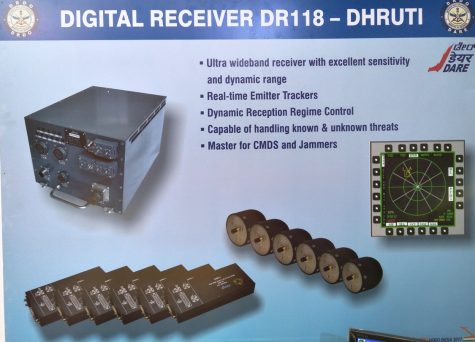
Radar warning receiver (RWR): Su-30MKI fleet are equipped with DARE developed Tarang-Mk2 Radar Warning Receiver (RWR) + High Accuracy Direction Finding Module (HADF). DARE now has developed all digital RWR christened ‘Dhruti’ for the Su-30MKI fleet, based on its experience on D-29 RWR developed for the Mig-29UPG fleet.
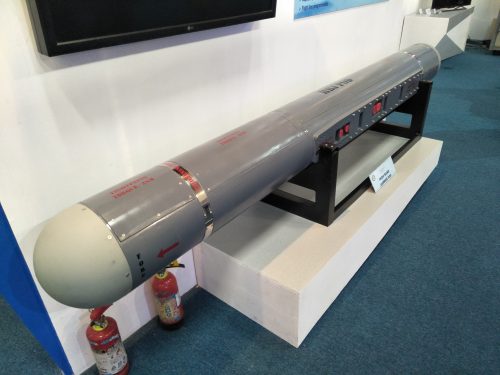
Self-Protection Jammer Pods: Su-30MKI fleet are equipped with Russian SAP-518 pods which due to poor performance was supplemented with Israeli Elta EL/L-8222 Airborne Self Protection Jammer (ASPJ) pods, which now have been offered with wideband EL/L-8222WB pods. DARE also has developed DARE’s High Band Jammer (HBJ) which has begun dummy trials in 2019. Infrared image search and track system (IRST): IAF’s Su-30MKI fleet is equipped with Russian OLS-30 IRST which soon will be replaced by India’s Bharat Electronics Limited (BEL) developed IRST which will be far more advanced and will be tuned to detect stealth aircraft at long range.
Integrated Radio Communication set (INCOM): Su-30MKI fleet are equipped with HAL developed Integrated Communication suite INCOM 1210A which will be replaced by indigenous Software Defined Radio systems (SDRs) which are being developed by WESEE (Weapons and Electronics Systems Engineering Establishment) jointly with BEL for all fighter jets in IAF fleet. These SDRs will be jam-resistant with secure features.
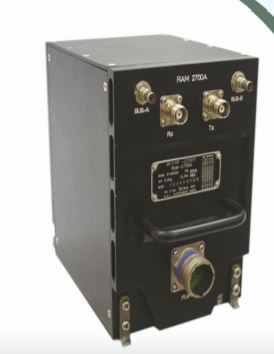
Radio Altimeter: HAL developed RAM-1701 is equipped on the Su-30MKI fleet which likely will be replaced likely by more advanced RAM-2700A which was developed for Jaguar and LCA-Tejas fleet. They are more countless system which can be replaced by Indian made one.
https://idrw.org/does-india-have-th...i-fleet-into-super-30-on-its-own/#more-224422

A country which pans to develop its own 5th Generation fighter jet and is already is working on the development of Tejas-Mk2 a 4.5+ Generation fighter and already has developed Tejas Mk1 4th Gen fighter and now plans to develop a Mk1A 4++ Gen fighter is still depended on the original equipment manufacturer for upgradation and modernization of what it calls the backbone of its airforce fleet? , let examine if India has local technology to upgrade them in the first place. Since IAF is only planning to upgrade only its avionics and electronics so this report will focus on this aspect.

AESA RADAR: NIIP N011M Bars radar, which is a passive electronically scanned array (PESA) system will be replaced by a derivative of the N036 X-Band AESA radar used on the 5th Generation Su-57 fighter jet. India’s indigenous Uttam AESA radar under development for the Tejas-Mk2 is a scalable radar that can be scaled up or down depending on antenna size requirement. Uttam AESA radar for Su-30 will require a larger bigger antenna which packs more T/R modules to take advantage of bigger space of the frontal nose cone of the Su-30MKI.

New Mission Computer: The Su-30MKI fleet is equipped with Mission Computer cum Display Processor-MC-486 and DP-30MK developed by India’s very own Defence Avionics Research Establishment (DARE) in 1998. The 32-bit mission computer performs mission-oriented computations, flight management, reconfiguration-cum-redundancy management, and in-flight systems self-tests. In compliance with MIL-STD-1521 and 2167A standards, Ada language was adopted for the mission computer’s software. According to DARE it already has developed Advanced computers for next-generation aircraft and one developed for Tejas Mk1 and Mk2 which are PowerPC based computing architecture which is a 64-bit which is a big improvement in processing power.

Upgraded Su-30MKI Cockpit: India’s HAL already showcased newly upgraded cockpit which now features, Two 230mmx305mm high-resolution LCDs with a multifunction control panel with a wide 20°x30° field of view head-up display which brings it at par with the Cockpit of the Sukhoi Su-35. Samtel/DARE will develop new high-resolution LCDs.

Radar warning receiver (RWR): Su-30MKI fleet are equipped with DARE developed Tarang-Mk2 Radar Warning Receiver (RWR) + High Accuracy Direction Finding Module (HADF). DARE now has developed all digital RWR christened ‘Dhruti’ for the Su-30MKI fleet, based on its experience on D-29 RWR developed for the Mig-29UPG fleet.

Self-Protection Jammer Pods: Su-30MKI fleet are equipped with Russian SAP-518 pods which due to poor performance was supplemented with Israeli Elta EL/L-8222 Airborne Self Protection Jammer (ASPJ) pods, which now have been offered with wideband EL/L-8222WB pods. DARE also has developed DARE’s High Band Jammer (HBJ) which has begun dummy trials in 2019. Infrared image search and track system (IRST): IAF’s Su-30MKI fleet is equipped with Russian OLS-30 IRST which soon will be replaced by India’s Bharat Electronics Limited (BEL) developed IRST which will be far more advanced and will be tuned to detect stealth aircraft at long range.
Integrated Radio Communication set (INCOM): Su-30MKI fleet are equipped with HAL developed Integrated Communication suite INCOM 1210A which will be replaced by indigenous Software Defined Radio systems (SDRs) which are being developed by WESEE (Weapons and Electronics Systems Engineering Establishment) jointly with BEL for all fighter jets in IAF fleet. These SDRs will be jam-resistant with secure features.

Radio Altimeter: HAL developed RAM-1701 is equipped on the Su-30MKI fleet which likely will be replaced likely by more advanced RAM-2700A which was developed for Jaguar and LCA-Tejas fleet. They are more countless system which can be replaced by Indian made one.
https://idrw.org/does-india-have-th...i-fleet-into-super-30-on-its-own/#more-224422
abhay rajput
New Member
- Joined
- Apr 10, 2016
- Messages
- 727
- Likes
- 1,549
This article got wrong information about jammer pods. Infact it's actually the opposite , elta jammer Never really worked on su30 when it's radar was on and with indigenous rwr. Sap518 works and very recently it has been seen on multiple su30mkis.Does India have the local tech to upgrade the Su-30MKI fleet into ” Super 30 ” on its own?

A country which pans to develop its own 5th Generation fighter jet and is already is working on the development of Tejas-Mk2 a 4.5+ Generation fighter and already has developed Tejas Mk1 4th Gen fighter and now plans to develop a Mk1A 4++ Gen fighter is still depended on the original equipment manufacturer for upgradation and modernization of what it calls the backbone of its airforce fleet? , let examine if India has local technology to upgrade them in the first place. Since IAF is only planning to upgrade only its avionics and electronics so this report will focus on this aspect.

AESA RADAR: NIIP N011M Bars radar, which is a passive electronically scanned array (PESA) system will be replaced by a derivative of the N036 X-Band AESA radar used on the 5th Generation Su-57 fighter jet. India’s indigenous Uttam AESA radar under development for the Tejas-Mk2 is a scalable radar that can be scaled up or down depending on antenna size requirement. Uttam AESA radar for Su-30 will require a larger bigger antenna which packs more T/R modules to take advantage of bigger space of the frontal nose cone of the Su-30MKI.

New Mission Computer: The Su-30MKI fleet is equipped with Mission Computer cum Display Processor-MC-486 and DP-30MK developed by India’s very own Defence Avionics Research Establishment (DARE) in 1998. The 32-bit mission computer performs mission-oriented computations, flight management, reconfiguration-cum-redundancy management, and in-flight systems self-tests. In compliance with MIL-STD-1521 and 2167A standards, Ada language was adopted for the mission computer’s software. According to DARE it already has developed Advanced computers for next-generation aircraft and one developed for Tejas Mk1 and Mk2 which are PowerPC based computing architecture which is a 64-bit which is a big improvement in processing power.

Upgraded Su-30MKI Cockpit: India’s HAL already showcased newly upgraded cockpit which now features, Two 230mmx305mm high-resolution LCDs with a multifunction control panel with a wide 20°x30° field of view head-up display which brings it at par with the Cockpit of the Sukhoi Su-35. Samtel/DARE will develop new high-resolution LCDs.

Radar warning receiver (RWR): Su-30MKI fleet are equipped with DARE developed Tarang-Mk2 Radar Warning Receiver (RWR) + High Accuracy Direction Finding Module (HADF). DARE now has developed all digital RWR christened ‘Dhruti’ for the Su-30MKI fleet, based on its experience on D-29 RWR developed for the Mig-29UPG fleet.

Self-Protection Jammer Pods: Su-30MKI fleet are equipped with Russian SAP-518 pods which due to poor performance was supplemented with Israeli Elta EL/L-8222 Airborne Self Protection Jammer (ASPJ) pods, which now have been offered with wideband EL/L-8222WB pods. DARE also has developed DARE’s High Band Jammer (HBJ) which has begun dummy trials in 2019. Infrared image search and track system (IRST): IAF’s Su-30MKI fleet is equipped with Russian OLS-30 IRST which soon will be replaced by India’s Bharat Electronics Limited (BEL) developed IRST which will be far more advanced and will be tuned to detect stealth aircraft at long range.
Integrated Radio Communication set (INCOM): Su-30MKI fleet are equipped with HAL developed Integrated Communication suite INCOM 1210A which will be replaced by indigenous Software Defined Radio systems (SDRs) which are being developed by WESEE (Weapons and Electronics Systems Engineering Establishment) jointly with BEL for all fighter jets in IAF fleet. These SDRs will be jam-resistant with secure features.

Radio Altimeter: HAL developed RAM-1701 is equipped on the Su-30MKI fleet which likely will be replaced likely by more advanced RAM-2700A which was developed for Jaguar and LCA-Tejas fleet. They are more countless system which can be replaced by Indian made one.
https://idrw.org/does-india-have-th...i-fleet-into-super-30-on-its-own/#more-224422
Articles
-
India Strikes Back: Operation Snow Leopard - Part 1
- mist_consecutive
- Replies: 9
-
Aftermath Galwan : Who holds the fort ?
- mist_consecutive
- Replies: 33
-
The Terrible Cost of Presidential Racism(Nixon & Kissinger towards India).
- ezsasa
- Replies: 40
-
Modern BVR Air Combat - Part 2
- mist_consecutive
- Replies: 22
-
Civil & Military Bureaucracy and related discussions
- daya
- Replies: 32
